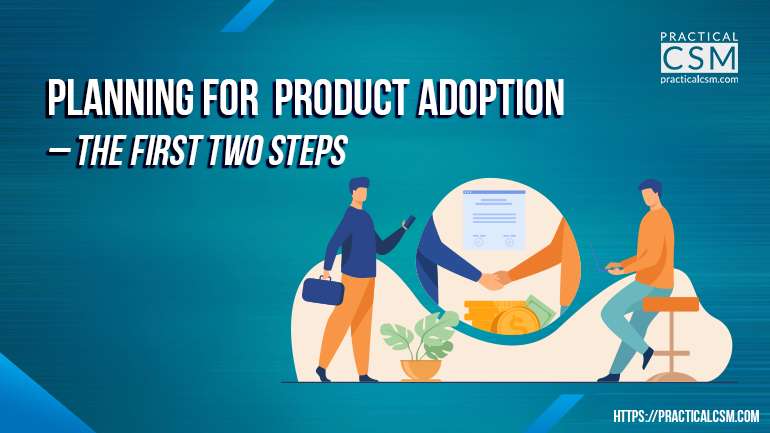Planning for Product Adoption – The First Two Steps
Introduction
Depending upon the product (or service) in question, full product adoption can be a potentially quite complex and even onerous task to perform well. As with all complex tasks, the secret is to break it down into its constituent components and then to deal with each component one at a time (as much as possible at least). There are many ways in which product adoption could be divided up and broken down into separate parts. The steps I have divided up adoption planning into are shown below:
Step 1: Determine Adoption Requirements
Step 2: Identify Process Changes
Step 3: Create Impacted Groups (IGs)
Step 4: Document Practical Considerations
Step 5: Determine Communication, Training and Support Requirements
Step 6: Capture Adoption Barriers and Risks
Step 7: Create Outline Adoption Plan
Step 8: Create Adoption Proposal and Gain Acceptance
Step 9: Complete Full Adoption Plan and Publish Adoption Roadmap
In the article below I explain the first two steps in adoption planning, taken from Chapter 8 of my book Practical Customer Success Management. Next week I’ll publish Steps 3 and 4. Of course being a chapter from the mid to later stages of the book, it does assume knowledge attained from previous chapters, and it also mentions downloadable tools that purchasers of the book have access to. But hopefully as a standalone series of articles it will provide a useful reference for CSMs who are looking for a way to break down the adoption planning process into a series of tasks and to learn how to perform each task efficiently and effectively. Also just to mention that of course adoption planning (and the use of the tools discussed herein) is also covered in detail in my Certified CSM Professional training program and within the upcoming Practical CSM Academy subscription site.
Step 1: Determine Adoption Requirements
Understanding the customer’s adoption requirements
The adoption start point from a practical perspective is to ensure there is consensus within the customer’s key stakeholder group on adoption outcomes and other adoption related needs – in other words on what it is the customer needs to achieve through the implementation of the adoption plan, and how they intend to go about planning, implementing and measuring that adoption plan. This may often be as straightforward for the CSM to learn as asking the SPL (the “Senior Project Lead” – my own shorthand for the customer stakeholder that the CSM engages with on a day-to-day basis) and documenting what they say. However in more complex situations this might need much more careful handling – particularly when multiple key stakeholders with perhaps very differing and sometimes even opposing viewpoints are involved in the decision making and/or where there is less experience within the customer organization of managing the sorts of changes required by the current initiative. What needs to decided and documented includes:
- Key objectives (outcome requirements)
- Who will be involved in the research and planning processes
- Which users are impacted by the initiative and whose adoption needs therefore need to be included
- Who will be involved in funding and implementing the plan
- How progress will be measured
- Who will take those measurements and provide progress reports
- Who will provide the ultimate sign off on a “job well done” and confirm the investment was worth it?
Chapter 4 of my book Practical Customer Success Management provides more detailed information relating to performing basic research during Practical CSM Framework Phase 1: Preparation. CSMs who have purchased the book and have adopted the Practical CSM Framework can refer to the Customer Research Checklist document which in previous chapters they were encouraged to create and store in a Central Repository to refresh their memory as to how much of this information is already known and documented and how much of it is as yet unknown and still needs to be determined. An Adoption Requirements Questionnaire is also provided as a download which the CSM can use to document all this information in one place within the first worksheet of this workbook.
The workshop as a forum for determining adoption requirements
The workshop is an ideal forum to use when multiple stakeholders with differing opinions need to come together to discuss, argue, negotiate, and where necessary make compromises in order ultimately to facilitate agreement on a chosen way forward for something. This fits well for situations where several customer stakeholders from a variety of departments need to work out and agree on these details. For more information about how to run a workshop please refer to Chapter 7 of my book Practical Customer Success Management.
The role of the CSM is to provide advice and assistance to the SPL to help them decide whether a workshop is required or not. If so, the CSM and SPL must also discuss agree who would be the right person to lead it and also the CSM should advise the SPL whether workshop facilitation is included within the services offered by the customer success team at no charge or whether it should be offered as a separately billable professional service. There is no right or wrong answer to the above, as it really does depend upon the specific circumstances of the customer, the CSM’s company and the relationship that exists between them. If CSMs decide to take on the role of facilitating an adoption requirements workshop themselves they should consider liaising closely with and perhaps jointly leading this workshop with the SPL. Other options might include business architects and management consultants from the customer organization, the CSM’s company or third party specialist organizations.
Other ways of determining adoption requirements
What if the workshop does not seem to be the right way forwards for determining the customer’s adoption requirements, but information regarding these requirements is missing and needs to be researched and/or determined? In this circumstance the CSM might use a combination of other research techniques including one-to-one or group meetings with key stakeholders and follow up research to uncover specific user groups’ needs and/or opinions using techniques such as focus groups, surveys and observation. Whereas there may be a case to be made for the CSM performing the role of workshop facilitator, it may be harder for the CSM to take on these tasks since they are likely to be quite onerous in terms of time and also will require access to various groups of users within the customer’s organization that it may be easier for the customer to access themselves.
Whichever way the job is done, the CSM must ensure that the information is collected and validated by the SPL as being accurate and complete. The CSM should then make sure that the information is documented, either by completing the first workbook within the Adoption Requirements Questionnaire or using some other way as desired.
Step 2: Identify Process Changes
Processes and capabilities
The start point for performing research to understand which users will be impacted by change and in what ways they will be impacted is to identify the process changes within each capability that will be impacted by the initiative. The output from this first step will be a list of impacted capabilities and for each impacted capability an explanation for what process changes will occur and who is involved in each process.
As we have seen in previous chapters, a process is a series of steps that are followed in the performance of an activity. These steps are pre-defined and are repeated each time that activity takes place. Processes are therefore contained within each business capability, which you may recall we defined as the ability of the customer’s business to perform a specific task in order to attain an output.
Note that the customer organization may refer to “processes” as “workflows”. Technically there is a small difference between a process and a workflow (though it depends which authority you decide to reference as to exactly what that difference is), but to all practical intents and purposes these two terms are interchangeable and therefore either term is fine to use, so my recommendation is to use whichever term the customer is most familiar and comfortable with.
Utilizing previous customer research
The likelihood is that this task will already have been completed by the customer organization (with or without the help of the CSM’s own company or other third parties) during the pre-sales process. However it is also perfectly possible that either this task was performed but in a summary rather than detailed fashion since this was all that was necessary at the time, or that it was not performed at all. If any existing research was performed the CSM should review it to determine its level of completion and accuracy.
Practical steps for researching impacted capabilities and processes
One way or another, the CSM needs to ensure that the necessary research takes place to understand and document which business capabilities will be impacted by the initiative. The process changes for each impacted business capability can either be researched at the same time or as a follow-up activity, depending upon circumstances. It can often be easier to combine these two tasks, since it may well be the same stakeholder/s that have both sets of information and it may make sense to interview them once rather than twice.
In terms of practical steps to take, the CSM should discuss the task with the SPL and start by reviewing any existing documentation from previous activities. The SPL and CSM can then discuss what details are missing and can come to an agreement as to what research needs to be done and who will perform it. It may not be the role of the CSM to actually perform this research, because the information is internal to the customer organization and will be held by process owners, team leaders and so on. However it is the role of the CSM to help to make sure it is performed correctly and thoroughly and that the information obtained is documented in an appropriate format. If necessary the CSM can make recommendations to the SPL regarding the appropriate research techniques to deploy and the types of stakeholders within the customer’s organization to approach (again please see Chapter 7 of my book for information about these).
Documenting impacted capabilities and processes
The resulting information from these activities is likely to be in the form of access to or copies of documentation that already existed in a variety of locations within the customer organization and that was created for other purposes. As such it may need to be reformatted into one comprehensive document that contains just the information required by the CSM and SPL for the purposes of adoption planning. A template for this purpose is provided in the second worksheet of the Adoption Requirements Questionnaire. This provides a way to list the different processes that will be impacted together with who is involved with the performance with them, and to document the anticipated changes for each process.







